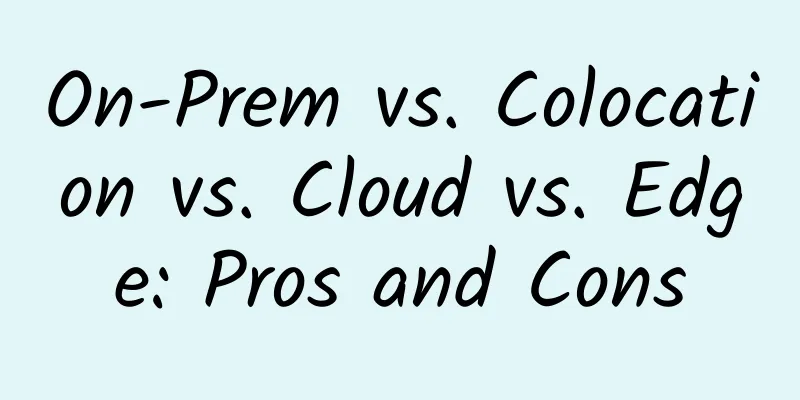An article to introduce you to network protocols

|
Author | Cai Zhuliang 1. Directory
I hope this article will help readers understand what network protocols are, as well as the http and https that we are most commonly exposed to. 2. Network ProtocolNetwork protocols are rules, standards or conventions established for data exchange in computer networks. As we all know, the Internet is a "big network" composed of computers, communicating with each other and exchanging data. We also know that there must be differences between computers produced by different computer manufacturers, so how do they overcome these differences to communicate? Obviously, it is "language". Our language can communicate with each other because we have a consensus on these definitions, such as apple refers to a specific fruit, etc. Computers also complete communication by establishing this agreement. But be careful! This network protocol is not only used by computers to use each other, but also for all devices on the network (servers, personal PCs, switches, routers, firewalls, etc.). Most networks use a layered architecture, where each layer is built on top of its lower layer, providing certain services to its upper layer, and shielding the details of how to implement this service from the upper layer (this is similar to the interface in our code). The rule for the nth layer on one device to communicate with the nth layer on another device is the nth layer protocol. There are many protocols in each layer of the network. The protocols of the same layer of the receiver and the sender must be consistent, otherwise one party will not be able to recognize the information sent by the other party. Network protocols enable various devices on the network to exchange information with each other. It was mentioned above that most networks use layered architecture. Here is the layered model:
The similarities and differences between the TCP/IP protocol family layering and the OSI layering are shown in the following figure: Next, we will draw a simple scene through network request. Scenario: I wrote a simple static page called "hello world" for the company and deployed it on the company's server. I used my own computer at home to access this static page through the public network. For example, the URL is "http://www.xxx.com". What did the browser do when I visited this URL? Let's look at the following picture: TCPTCP (Transmission Control Protocol) is a connection-oriented, reliable, byte stream-based, bidirectional transport layer communication protocol. It will go through three handshakes when establishing a connection, and will not start transmitting data until the three handshakes are completed; when terminating a connection, it needs four handshakes. The details are as follows: (1) Establishing a connectionImage source: Baidu Encyclopedia Three-way handshake:
The client and server enter the Established state and can start sending and receiving data. (2) Terminate the connectionImage source: Baidu Encyclopedia
The party that actively initiates the close is responsible for the final confirmation of FIN. In this example, the client needs to receive FIN and reply ACK to the server, entering the TIME_WAIT state. After the server receives ACK, it enters the CLOSED state. Why do we wave four times when it ends? Because one party actively initiates close and sends FIN, it only means that it will no longer send data, but it can still receive data, so the other party needs to close and send FIN to notify the other party. As for why ACK and FIN should be separated? Because ACK tells the other party "I know", while FIN tells the other party "I don't have any data to give you anymore". In reality, it is not necessarily that I have given all the data to the other party when I receive FIN, so they need to be separated. HTTPHTTP (HyperText Transfer Protocol), Hypertext Transfer Protocol, is implemented based on TCP protocol. HTTP is a stateless protocol. When we visit a page as a visitor, the stateless protocol is simple and efficient. However, in e-commerce scenarios, it is necessary to record the user's login status or shopping cart product information (in addition to e-commerce, some middle-end systems also need to record user status, just for example), so some additional technical assistance is needed, such as cookies. HTTP message format The structures of HTTP request and response messages are basically the same. The message consists of three parts:
HTTPSHTTP is implemented based on TCP. Its messages are in plain text. The entire transmission process is completely transparent and can be easily intercepted and modified at any stage. This is very unsafe. Therefore, the secure HTTP protocol came into being - HTTPS. HTTPS is actually HTTP with SSL added. (1) SSL/TLSSSL stands for Secure Sockets Layer, which was renamed TLS (Transport Layer Security) in 1999. There are a few concepts to clarify first:
(2) The HTTPS workflow is roughly as follows:Complete the three-way handshake first, which is consistent with HTTP
(3) Advantages
(4) Disadvantages
Due to this shortcoming, we need to rely on third-party organizations to help make our HTTPS more secure and reliable. The details are as follows:
Public key user information Public Key sign Obtain data summary through hash (public key, company information, domain name and other application information); CA then encrypts the summary information, and this ciphertext is the signature CA Information Validity Certificate serial number
To summarize, the security of our HTTPS is based on trust in the root certificate and the encryption algorithm, so we believe that it is safe. As mentioned above, our security can only be discussed based on a certain trust point, so there is no absolute security. If a hacker hijacks the browser and makes all your requests go to him first, and then to the server, then all the data you request will go to the hacker first, and then it will be unsafe. For example: many of our ladders are proxies. The requests sent by the browser are proxied by it, and then go to the server that can bypass the firewall to request resources. The data obtained is naturally returned by the original route, so this transit server can perform many operations. I believe that by now, everyone has already known that the network layered architecture we often talk about is generally defined as 5 layers or 7 layers, and the network protocol we talk about is the communication protocol for a certain layer. Here we take the most commonly used http and https as examples to explain, and talk about their differences, and also extend the content of network security. About the AuthorCai Zhuliang, 51CTO community editor, has been engaged in Java backend development for 8 years. He has worked on traditional radio and television BOSS systems, and later devoted himself to Internet e-commerce, where he was responsible for orders, TMS, middleware, etc. |
Recommend
The demand for optical fiber and cable market is higher than expected, and my country will usher in a traffic economy
At present, my country accounts for the largest s...
Forgot your switch password? Don’t panic, here are detailed solutions!
It is said that many people are confused about th...
Why are IDC companies keen on entering the broadband access network field?
Since the country launched the pilot business of ...
Anynode: $15/year KVM-1GB/20G SSD/2TB/Las Vegas
The last time I shared information about Anynode ...
Countries are launching alliance strategies to compete for the right to formulate 6G standards
As many countries have suffered losses in the pac...
Analysis on the current status of global 5G development
[[417613]] This article is reprinted from the WeC...
The time is ripe, and it is expected that 2G/3G network withdrawal will be completed in 3 to 5 years
"Talented people emerge in every generation,...
Chen Jinqiao: China's 4G network sets a world record and its network quality is the best in the world
On December 23, at the annual APP awards ceremony...
Various abnormal phenomena and analysis from TCP protocol to TCP communication (Part 2)
Today we continue to introduce the content about ...
Regarding 2G network withdrawal, this article can be said to be very comprehensive
The withdrawal of 2G network is actually not a ne...
Will the 6G market size exceed $1 billion in 2028? What are its typical features and potential applications?
Industry experts point out that 6G will achieve s...
12% off on all CUBECLOUD products, Los Angeles special annual payment starting from 230 yuan
CUBECLOUD has launched a promotion during the Mid...
New electromagnetic wave router will enable unlimited bandwidth
UCLA researchers, with support from the Defense A...
Ministry of Industry and Information Technology: China's 5G investment reached 184.9 billion yuan in 2021
On January 25, China's Ministry of Industry a...









